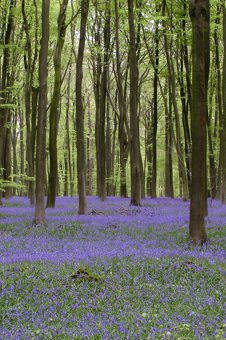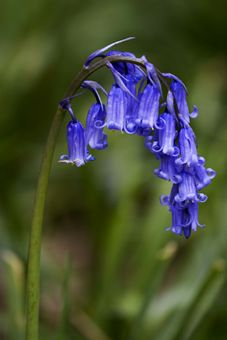
Bluebells
Bluebells can be seen flowering in late April and May, and are a wonderful sight in lanes and woodlands around Overton.
There are three species of bluebell: Common; Italian and Spanish, with one hybrid. They form the genus Hyacinthoides and are classified in the Hyacinthaceae family.
The Common Bluebell (Hyacinthoides non-scripta) is found in north western Europe, predominantly in the British Isles, northern France, Belgium and the Netherlands. It is a bulb forming perennial plant that produces violet flowers covering the floor of a woodland in spring before the main canopy develops.
The Spanish (Hyacinthoides hispanica) and Italian (Hyacinthoides italica) species are predominantly found in Spain and Italy, respectively. Unlike the common bluebell these species will grow in full sun and the Spanish Bluebell has been extensively planted in gardens throughout western Europe.
The UK is home to over a quarter of the world's population of Common Bluebells, so we have an international obligation to protect this species. Threats to our native bluebell include possible cross-breeding with the Spanish bluebell, habitat loss and illegal bulb collection.
Identification
The Common Bluebell flowers in April and May. The stems are 10-30 cm long and bend over at the top. The lavender-blue flowers are pendulous, bell-shaped and slightly fragrant. The anthers are yellowish-white. They tend to form dense woodland carpets of flowers.
The Spanish Bluebell is distinguished from the Common Bluebell by its paler, larger blue flowers, more erect flower stem (raceme), broader leaves, blue anthers and little or no scent compared to the stronger fragrant scent of the Common Bluebell.
The Italian and Spanish/Common hybrids are very similar and both appear intermediate in appearance between the Spanish and Common Bluebells. They have intermediate leaves and a dense conical flowering raceme 10-40 cm tall.

Did You Know?
- The name 'non-scripta' means 'unlettered', and distinguishes this species from Hyacinthoides orientalis (the garden Hyacinth), on which the god Apollo was supposed to have written 'AI AI' (alas) to express his grief at the death of Prince Hyacinthus, from whose blood Hyancinthoides orientalis grew.
- The bluebell was voted the nation's favourite flower in Plantlife's County Flowers project in 2002.
- Bluebells frequently occur in ancient woodlands.
- In days gone by, people believed that bluebells rang to summon fairies to their gatherings, and that any human hearing these bells would soon die!
- Some bluebells lack the blue pigment, so have white flowers instead.
- Bluebells form a bulb, and take advantage of high light levels in spring to flower and store food before the woodland canopy closes over.
- Because bluebell bulbs contain toxins, they were used as a source of glue for bookbinding. This discouraged silverfish from attacking the books.
Bluebells and the Law
In the United Kingdom the Common Bluebell is a protected species under the Wildlife and Countryside Act 1981. Landowners are prohibited from removing bluebells on their land for sale and it is a criminal offence to remove the bulbs of wild bluebells. This legislation was toughened up in 1998 under Schedule 8 of the Act: the trade in common bluebell bulbs or seeds is an offence.
Links
- Plantlife Bluebell's Pages:
- Which Bluebell Is It? Identification Guide
- Bluebells of Britain (456 Kb PDF)
- Bluebell Report (1.94 Mb PDF)
- British bluebells at the Natural History Museum
- Hyacinthoides genus at Wikipedia
Images from wikipedia.org: Common Bluebell © Michael Maggs; bluebell wood © Jim Champion. Return to other field guides.
